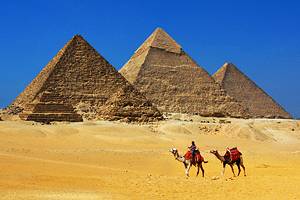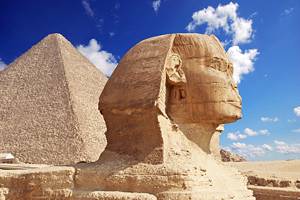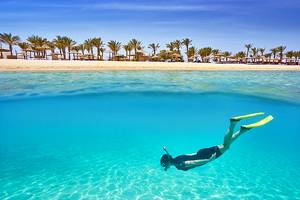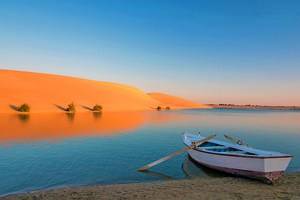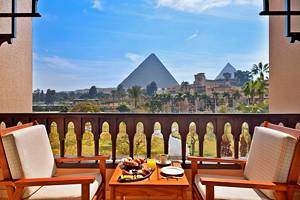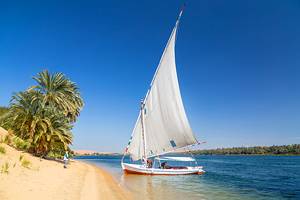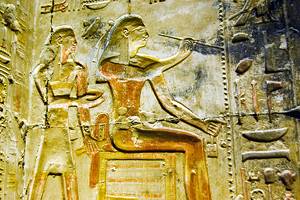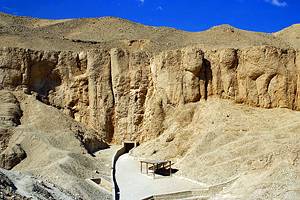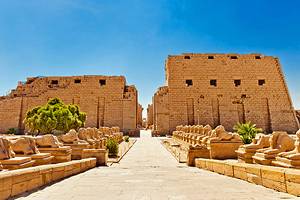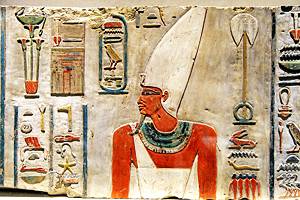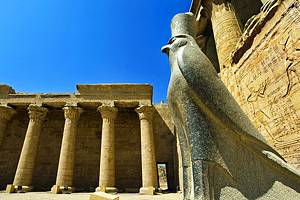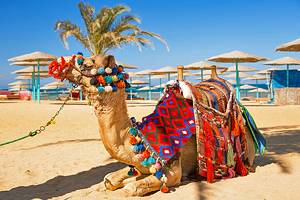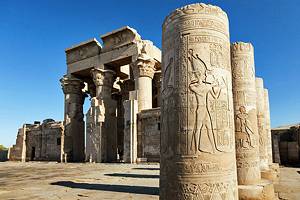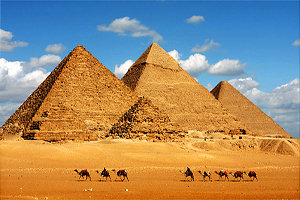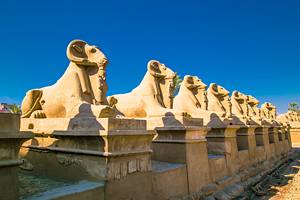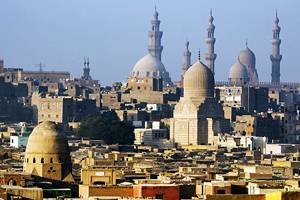Things to Do in Egypt
With most Egypt itineraries, sightseeing at the temples and tombs is definitely going to take up a lot of your time, but Egypt has plenty of things to do beyond its Pharaonic-era tourist attractions.
With its abundant sea life and colorful corals, the Red Sea is one of the best places to visit in the world for scuba diving, while the Sinai Peninsula and the Western Desert provide plenty of scope for adventure travel activities such as camping, desert 4WD touring, and camel riding.
Meanwhile Egypt's most iconic thing to do while here is taking a trip up or down the Nile, which combines viewing the highlights of Ancient Egypt's vast history with a scenic cruise.
Find out about the best activities to add into your trip with our list of the top things to do in Egypt.
- Cruise the Nile from Aswan to Luxor
- Dive the Red Sea at Sharm el-Sheikh
- Explore Luxor's West Bank by Bike
- Sail around Aswan on a Felucca
- Head to the Beach
- Camel Ride at the Giza Pyramids
- Hike up Mt Sinai
- Camp in the White Desert
- Explore the Thistlegorm Wreck
- Hot Air Balloon Ride over Luxor
- 4WD Tour of the Western Desert's Great Sand Sea from Siwa
- Cruise Lake Nasser to Abu Simbel
- Trek the Sinai Peninsula
- Kiteboard or Wakeboard in El Gouna
- Map of Things to Do in Egypt
Cruise the Nile from Aswan to Luxor

Hopping aboard a Nile cruise is Egypt's most relaxing sightseeing experience, as well as the most popular thing to do for visitors in the country.
The southern Nile Valley (Upper Egypt) between Luxor and Aswan is the most popular stretch of the Nile for a cruise for obvious reasons.
It is both home to the most famous of Egypt's grand riverside temples (Kom Ombo and Edfu), which make for easy stops along the journey, and the best rural Nile-side scenery, with the lush green thread of fertile fields and date-palm-lined riverbanks giving way to orange sand dunes beyond.
A normal Nile cruise along this route includes sightseeing in Luxor and Aswan making this an easygoing and comfortable way to tour that showcases the best of southern Egypt.
For a longer itinerary, there is also the option to cruise between Cairo and Luxor, or all the way down to Aswan.
The northern section of the Nile has far fewer sailings, but if your primary aim on your Egypt trip is to take in as many of Ancient Egypt's sights as possible, but still do it in comfort, this is an excellent option.
Dive the Red Sea at Sharm el-Sheikh

Before Sharm el-Sheikh became a favored winter sun destination for northern Europeans, it was primarily known for its scuba diving. Although far more visitors now arrive here looking for the simple pleasures of sun and sand, the diving in the Red Sea here is still first-rate.
Egypt's Red Sea is scattered with world-class dive sites, but two of the most famous dive destinations are easiest reached from Sharm el-Sheikh. Ras Mohammed National Park and the Straits of Tiran offer divers an undersea experience complete with vibrant corals, abundant sea life, and wrecks to explore.
If you're in Sharm specifically to dive, you may want to forgo the large luxury resorts and instead stay at one of the smaller dive-focused hotels, where services are totally arranged around your diving.
Explore Luxor's West Bank by Bike

During Egypt's winter months, when the blue sky days are pleasantly temperate, one of the most scenic ways to explore Luxor's west bank is by bike.
Touring the various temple and tomb sites this way allows for a more leisurely pace and plenty of opportunities to admire the landscape of green farming fields with the jagged escarpment behind.
For a leisurely and flat ride, cycle from the Nile ferry landing (bicycles are allowed onto the ferry for free), to the Colossi of Memnon and then do a loop between Medinat Habu Temple, the Tombs of the Nobles, the Ramesseum, and Deir Al-Bahri (Temple of Hatshepsut).
The road to the Valley of the Kings is a bit more of a slog, so leave that for a separate cycle ride and plan to set out early in the day (even in winter). A doable Valley of the Kings itinerary could incorporate both the Valley of the Kings and the Valley of the Queens or the Valley of the Kings and the tombs of Deir Al Medina.
Many of the hotels and guesthouses in Luxor, both on the east and west bank, either rent bicycles or offer them free to use for guests.
Sail around Aswan on a Felucca

The most iconic Nile views are all in Aswan and the best way to see them is to hop aboard a felucca.
Cast off from one of the boat landing points in central Aswan for a few hours, or an entire day, of gentle sightseeing around the islands in town.
A typical felucca itinerary includes stops at the Ruins of Abu on Elephantine Island, Aswan Botanical Gardens on Kitchener's Island, and the boat landings near the Monastery of St. Simeon and the Tombs of the Nobles on Aswan's west bank.
As all felucca itineraries are completely customizable, you can choose how many Aswan sights you want to see. Another popular, short option is a sunset felucca ride.
Head to the Beach

In the depths of the Northern Hemisphere winter, Egypt's beaches have become a welcome escape for European families seeking blue skies and easygoing fun.
The Red Sea coastline surrounding the towns of Hurghada and El Gouna, as well as the beaches of Sharm el-Sheikh in South Sinai, attract droves of sunseekers from around November to March.
All have plenty of resort choice, from vast mega-resorts dedicated to family-friendly beach vacations to smaller boutique-style resorts marketed as romantic breaks.
Choose Hurghada or El Gouna if you want to be within day-tripping distance of the temples and tombs of Luxor. In Hurghada you can also find an assortment of all-inclusive resorts to make your beach trip that much more enjoyable.
Sharm el-Sheikh is the top choice for keen divers who want to explore the dive sites of Ras Mohammed and the Straits of Tiran.
Camel Ride at the Giza Pyramids

One of Cairo's most iconic things to do is camel ride at the pyramids. Due to the distances involved in exploring the site, it actually makes sense as well.
The best option is to camel ride south from the Pyramid of Mycerinus (Menkaure) into the desert to one of the panoramic viewpoints of the entire site.
For the best photography light (and most comfortable riding experience), time your ride for around sunset.
Camel touts proliferate around the site, offering their services. Always check if the camel looks healthy and well fed before agreeing, as camel welfare continues to be an issue at this site.
Also, agree on a price before riding, not during the ride or after. You will most likely need to haggle.
Hike up Mt Sinai

The most famous hike in Egypt, to the summit of Mt. Sinai (Gebel Mousa), can be achieved by anyone with a decent level of fitness.
There are two main trails up to the peak. The Camel Trail is a wide switchback trail up the slope and is the most popular route. As its name suggests, you can hire a camel (at the start of the trail) to take you most of the way up if you don't want to walk.
The Steps of Repentance is a steeper staircase of 3,750 rough-cut stone steps and was laid out by a monk from St. Catherine's Monastery. The mountain views are astounding along the way, and there are far fewer people tackling this route, so it's much more peaceful.
The typical guided tour from Sharm el-Sheikh and Dahab tackles the mountain to get to the summit for sunrise. For a quieter experience (where you could likely be the only people on the mountain) in the cooler months, come independently and hike during the day.
Camp in the White Desert

White Desert National Park is where you come to experience one of Egypt's most surreal landscapes.
The wind-sculpted chalk rock outcrops of White Desert National Park are the Western Desert region's most surreal landscapes and prime territory for desert camping trips under star-strewn skies.
Trips can be organized in Bahariya Oasis, which is also the easiest oasis to reach from Cairo.
A typical White Desert itinerary stops at several sites within the national park. These normally include Crystal Mountain (an outcrop made entirely from quartz), an area where the smaller white rock formations have been eroded into fantastical shapes, and the part of the park where some of the more dramatic and tall chalk towers loom over valleys of sand.
After touring the White Desert, visitors bed down for the night within the park. At sunset and sunrise, the white rock spires and formations take on apricot tones. If you can time your trip for full moon, the light cast over the white rock here during the night is beautifully eerie.
Most White Desert camping tours also stop at the Black Desert, either on the way to or from the White Desert. Here, there are great photo opportunities of the rock-pitted plateau if you scramble up to the summit of Gebel Az-Zuqaq.
Explore the Thistlegorm Wreck

There are plenty of wrecks off the Red Sea coast to explore but the most famous is the Thistlegorm.
This World War II cargo ship, filled with supplies to aid Allied forces fighting in the Western Desert, was bombed by the Germans and sunk in 1941.
The wreck was located by famed French diver Jacques Cousteau in 1956, but as he didn't disclose its location, it was only in the mid-1990s, when it was rediscovered, that the site was opened for recreational diving.
Although it is possible to day trip to the site by boat, due to the travel time, the best way to dive here is by liveaboard (overnight boat trips), which allow you more time at the site.
A typical one-night liveaboard Thistlegorm trip includes two dives at the site, allowing ample opportunity to explore the ship's interior and exterior.
Hot Air Balloon Ride over Luxor

Luxor's west bank, with its temples and monuments set between a patchwork of lush farming fields and small villages, is one of the world's great historic landscapes, and a hot air ballooning ride here offers a unique perspective over the riches below.
You'll need to get up early, as hot air balloon rides only lift off at sunrise, but the early start is worth the wake-up call for the soft morning light, which is the best for photography.
During the flight, you'll be able to view the West Bank's landscape in total, with the sinuous curves of the Nile River bordering it to the east, and the looming orange-hued escarpment, which hides the famed royal tombs of the Pharaonic era, to the west.
Read More: Hot Air Balloon Rides in the World
4WD Tour of the Western Desert's Great Sand Sea from Siwa

Siwa Oasis sits in splendid isolation, out in the far west of Egypt's Western Desert, but the long trip out here is well worth it for anyone who wants to experience the majesty of the Western Desert's Great Sand Sea.
The very northern edge of the Great Sand Sea, with its waves of mammoth sand dunes, is accessible from Siwa. Operators here offer overnight camping trips into the area, so you can experience the orange-hued dunes in the soft light of sunrise and sunset, as well as the star-strewn desert sky. Many tours also offer the added opportunity to sandboard on some dunes if you need more action than simply soaking up the scenery.
All tours out into the desert surrounding Siwa need permits, which your operator will normally organize for you.
Cruise Lake Nasser to Abu Simbel

When people say they're taking a cruise in Egypt, they're typically talking about the Nile, but Lake Nasser is an alternative cruising option.
Created by the filling of the Aswan High Dam, Lake Nasser stretches for 510 kilometers south from Aswan and into Sudan, through the heart of what was Ancient Nubia.
For historically minded travelers, a Lake Nasser cruise is all about exploring the scatter of temples and ruins along the lake's shore. Nearly all the surviving monuments here were moved to their current positions during the 1970s UNESCO-funded project, which saved them from being submerged by the dam's rising waters.
The highlight of a Lake Nasser cruise is approaching and viewing the shorefront Temples of Abu Simbel from the water.
Trek the Sinai Peninsula

The South Sinai is Egypt's best trekking destination, with plenty of multi-day hiking opportunities through the desert mountain region of the Sinai Peninsula.
All treks here have to be guided. Independent trekking isn't allowed for safety considerations due to the inhospitable desert environment, complete lack of way-marking of trails, and the official permissions necessary to trek here.
Treks also need to be completely self-sufficient in supplies, which on multi-day trails means the support of camels to carry water and gear.
St. Catherine's, in the heart of the Sinai Mountains, is the main hiking center for organizing both day hikes and multi-day treks. Popular shorter treks include summiting Mt. St. Catherine (Gebel Katarina) and other nearby peaks.
A vast trail network known as the Sinai Trail threads through this region, connecting the coastal towns of Sharm el-Sheikh, Dahab, and Nuweiba with St. Catherine's and beyond.
Kiteboard or Wakeboard in El Gouna

Just north of Hurghada, on Egypt's Red Sea coast, the purpose-built resort town of El Gouna has become a major water sports center.
Near constant winds offshore mean El Gouna is prime territory for kiteboarding and now several operators in town offer kiteboarding lessons, kiteboarding equipment rental, and kiteboarding vacation packages that include all accommodation and several days of instruction, or safari trips to prime kiteboarding locations along the coast.
For wakeboarders, the opening of Sliders Cable Park in the south of town has made El Gouna a world-class wakeboarding destination.
This Olympic-standard park offers wakeboarding instruction for beginners, as well as providing plenty of jumps and obstacles along the cable course to keep intermediate and advanced wake-boarders occupied.


